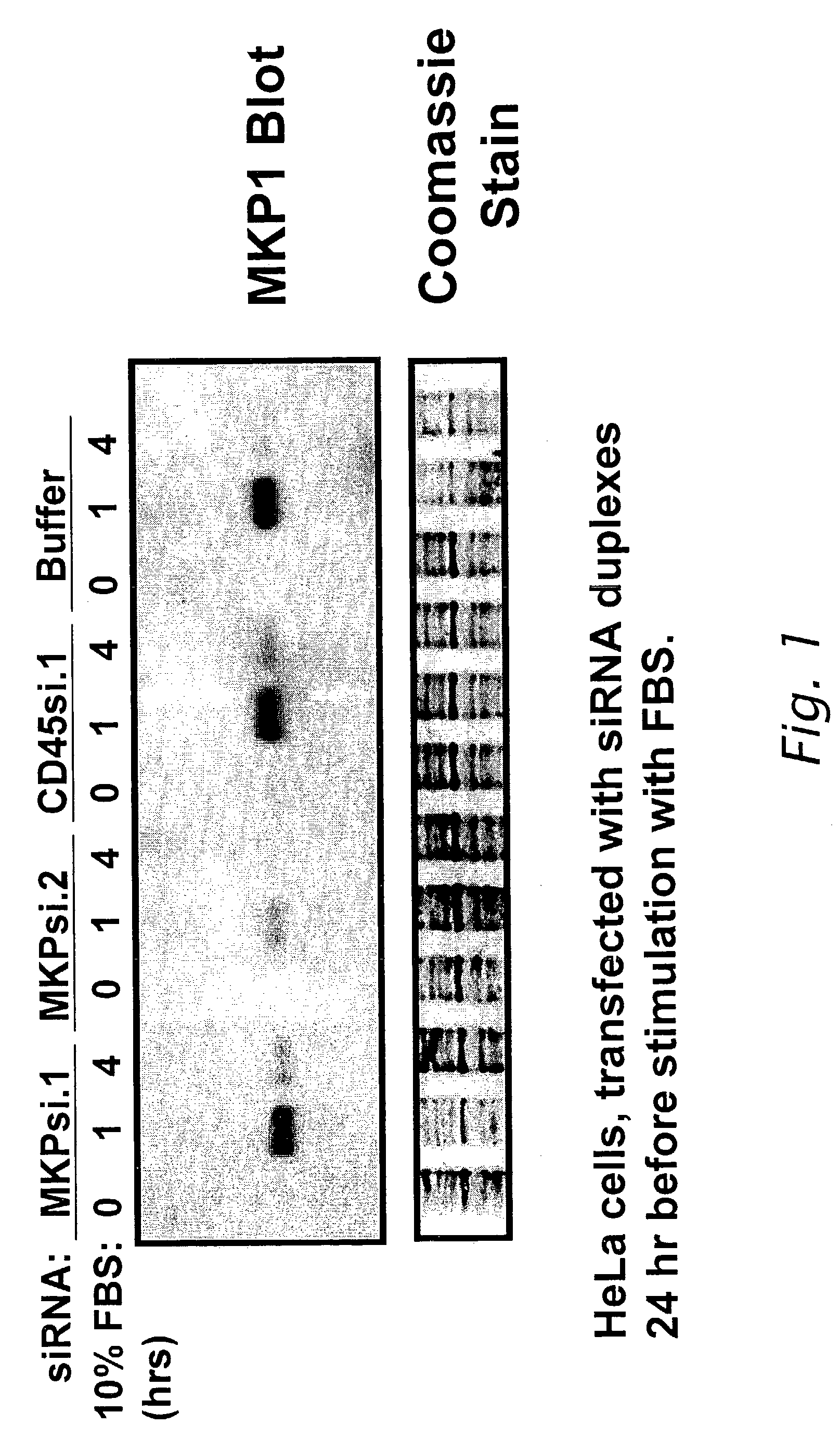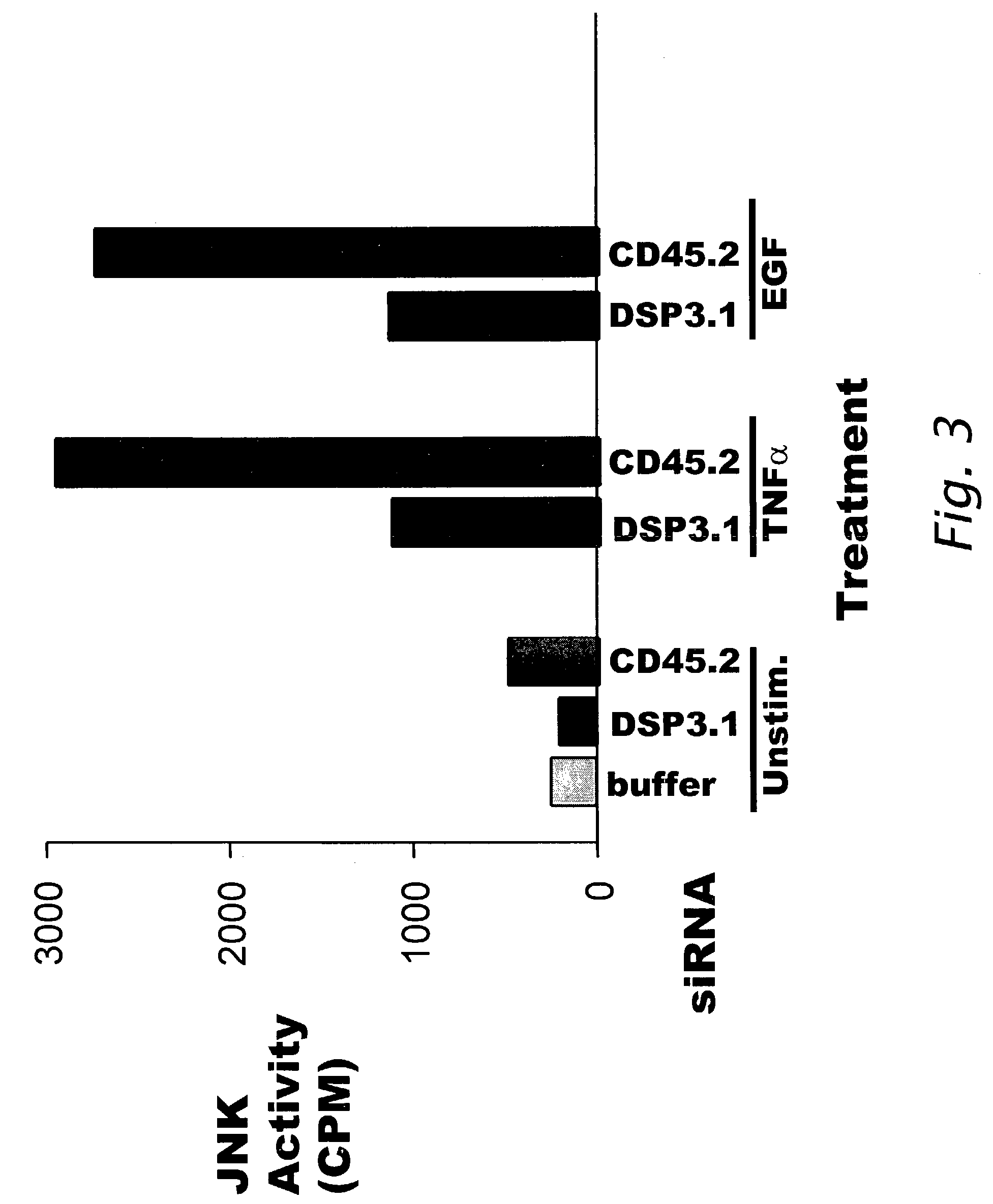Modulation of biological signal transduction by RNA interference
a biological signal and interference technology, applied in the field of double-stranded rna polynucleotides, can solve the problems of insufficient insulin production, inability to effectively use available cells and tissues, and inability to achieve effective intervention
- Summary
- Abstract
- Description
- Claims
- Application Information
AI Technical Summary
Benefits of technology
Problems solved by technology
Method used
Image
Examples
example 1
Interference of Dual Specificity Phosphatase Expression by Small Interfering RNA
[0149]This example describes the effect on dual specificity phosphatase (DSP) expression in cells transfected with sequence-specific small interfering RNA (siRNA) polynucleotides. Interference with expression of MKP-1 and DSP-3 was examined by transfecting sequence-specific siRNAs into mammalian cells expressing the DSP polypeptide and then detecting expression by immunoblot.
[0150]The siRNA nucleotide sequences specific for each DSP were chosen by first scanning the open reading frame of the target cDNA for 21-base sequences that were flanked on the 5′ end by two adenine bases (AA) and that had A+T / G+C ratios that were nearly 1:1. Twenty-one-base sequences with an A+T / G+C ratio greater than 2:1 or 1:2 were excluded. If no 21-base sequences were identified that met this criteria, the polynucleotide sequence encoding the DSP was searched for a 21-base sequence having the bases CA at the 5′ end. The polynuc...
example 2
Interference with Expression of Protein Tyrosine Phosphatases by Sequence-Specific Small Interfering RNA
[0164]This example describes RNA interference of transient and endogenous expression of various protein tyrosine phosphatases (PTPs).
Co-Transfection Assays to Determine Interference of PTP Expression by siRNA
[0165]DSP-11 and DSP-18
[0166]Interference of expression of FLAG®-tagged DSP-11 polypeptide and FLAG®-tagged DSP-18pr polypeptide (DSP-18) by sequence specific siRNA polynucleotides was determined. (FLAG® sequence: Asp-Tyr-Lys-Asp-Asp-Asp-Asp-Lys (SEQ ID NO: 13)) (Sigma Aldrich, St. Louis, Mo.). Two siRNA sequences that were specific for DSP-11 polynucleotide (SEQ ID NO: 780) encoding a DSP-11 polypeptide (SEQ ID NO: 781) and two siRNA sequences specific for DSP-18pr polynucleotide (DSP-18, SEQ ID NO: 782) encoding a DSP-18 polypeptide (SEQ ID NO: 783) were designed using the criteria described in Example 1. The following sequences were used in the experiments.
DSP-11 specific:
[...
example 3
Decreased Activation of JNK in the Presence of siRNA Specific for DSP-3
[0207]This Example describes the effect on JNK activation by sequence-specific siRNA interference of DSP-3 polypeptide expression.
[0208]HeLa cells were transfected with 60 pmoles of DSP3.1 siRNA (SEQ ID NO:3) or 60 pmoles CD45.2 (SEQ ID NO:33) as described in Example 1. After the incubation following transfection, cells were stimulated with 10 ng / ml TNF-α or 10 ng / ml EGF for 10 minutes or with 500 mM sorbitol for 30 minutes, which are known stimulators of the JNK signal transduction pathway (WO 01 / 21812; Shen et al. Proc. Natl. Acad. Sci. 98:13613-18 (2001)). After the stimulators were decanted, the 6-well plate of cells was frozen. The cells were treated with 0.5 ml Extraction Buffer (20 mM Tris, pH 8, 136 mM NaCl, 50 mM NaF; 1 mM V04; 0.2 mM EDTA, 0.2 mM EGTA, 20 nM Calyculin, 10% glycerol, 0.5% nonidet P40, 1 μg / ml of aprotinin, pepstatin, and leupeptin; and 1 mM Benzamidine) (4° C.). When the cells had partia...
PUM
| Property | Measurement | Unit |
|---|---|---|
| melting temperature | aaaaa | aaaaa |
| melting temperature | aaaaa | aaaaa |
| temperatures | aaaaa | aaaaa |
Abstract
Description
Claims
Application Information
 Login to View More
Login to View More - R&D
- Intellectual Property
- Life Sciences
- Materials
- Tech Scout
- Unparalleled Data Quality
- Higher Quality Content
- 60% Fewer Hallucinations
Browse by: Latest US Patents, China's latest patents, Technical Efficacy Thesaurus, Application Domain, Technology Topic, Popular Technical Reports.
© 2025 PatSnap. All rights reserved.Legal|Privacy policy|Modern Slavery Act Transparency Statement|Sitemap|About US| Contact US: help@patsnap.com



